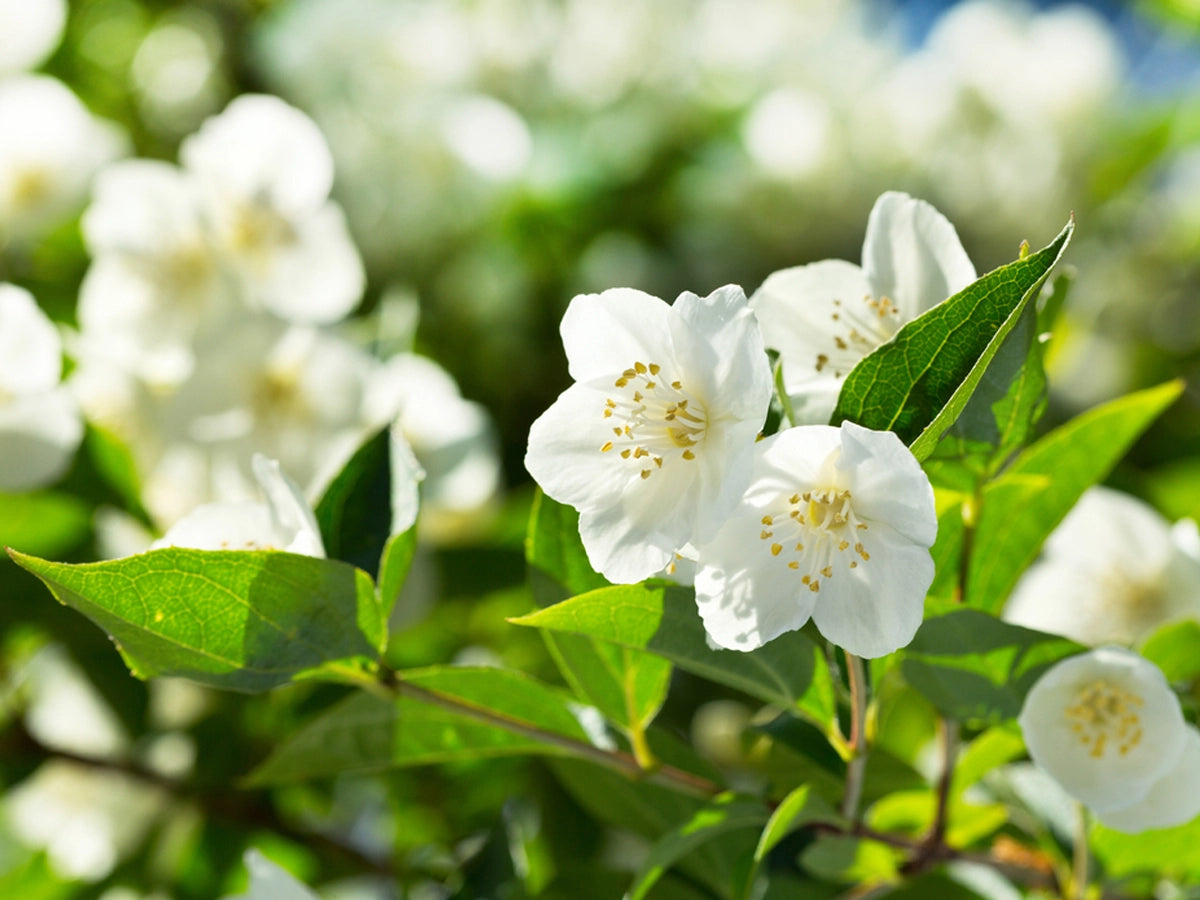How to Grow
Jasmine Growing and Care Tips – Add More Beauty to Your Garden
Besides color and petal structure, most flowers are known for their fragrance.
But can any flower beat the sweet and intoxicating aroma of jasmine?
There are multiple varieties of jasmine worldwide, and most of them have this strong fragrance.
Jasmine has been famous for centuries, not only for its scent but also as a hair accessory for Indian women. One of the many skills of the jasmine flower is its stress-relieving property, which helps calm an agitated mind and tired body.
Jasmine flowers are revered as representations of purity, peace, and love in numerous civilizations around the world.
What else?
Jasmine encourages sound sleep and is used copiously in the pharmaceutical and cosmetic industries.
Moreover, jasmine is an easy plant to grow at home, both indoors and outdoors. This blog will provide you with the necessary guidelines to grow jasmine at home. We will talk about the following aspects: -
- Interesting facts about Jasmine
- How to grow jasmine at home
- How to take care of jasmine
- Benefits and uses of jasmine
Let’s get started.
Interesting facts about Jasmine
- Do you know that jasmine is a member of the Olive family (Oleaceae)?
- There are around 200 species of jasmine, and they are either shrubs or vines.
- Jasmines are generally indigenous to tropical and warm temperate regions of Africa, Eurasia, and Oceania.
- The intoxicating fragrance of all jasmine flowers is their prime feature and a compelling reason behind their cultivation worldwide.
- The word jasmine is derived from the middle Persian word yāsaman.
- The jasmine shrubs can reach a height of 10–15 feet, while the vine jasmine can grow up to 25 feet.
- The scent of jasmine flowers is intensified by the drop in nighttime temperature. This not only intensifies the scent but also reveals the star-shaped petals of the blossoms. Jasmine is known as the "queen of the night" in our native India because of this.
- Jasmine oil is extracted from the jasmine flower which is a popular natural mood booster and stress remover.
- Do you know that jasmine is regarded as a national symbol of Hawaii, Indonesia, Pakistan, and the Philippines?
- In Thailand, jasmine symbolizes love and respect and is associated with mothers.
- The leaf, flower, and root of the jasmine plant are used in Ayurveda to treat skin problems, heart functions, dental issues, etc.
How to grow jasmine at home
Jasmine is one of the easiest flowering plants to grow at home, both indoors and outdoors. Read the growing tips explained below and benefit from the plant: -
Choose a type of jasmine to grow at home
There are more than 200 varieties of jasmine. Some trees are deciduous, while others are evergreen. Some resemble vines, while others resemble bushes. So, choose a jasmine that you want to grow at home. Star jasmine or summer jasmine (Jasminum officinale), winter jasmine (Jasminum nudiflorum), pink jasmine (Jasminum polyanthum), or night flowering jasmine would be the best varieties to grow at home.
Pick a location to grow
Although a few varieties can tolerate full shade, most jasmine plants need a medium to full light. Some jasmine varieties develop into vines, some spread out along the ground and act as useful ground cover, and some grow as shrubs. Choose a planting location that works with the variety you have.
Soil Preparation
- Organically rich, well-draining soil is best for jasmine flowering plants. Prepare the soil by working in a 2-inch layer of compost whether you're planting your jasmine in the ground or a pot. By doing this, the plant will produce strong blossoms throughout the growing season.
- If you're planting outside, be sure the location has good drainage. Check that by digging a hole and pouring water. If the water soaks up easily and quickly, leaving an empty hole, the soil has good drainage.
Planting jasmine
It is necessary to let you know that planting jasmine from seeds will take time to mature because jasmine seeds have a low germination rate. You can also grow jasmine with the stem-cutting method. However, buying a plant from a nursery is an easier process because most of the groundwork is done.
- Buy a jasmine plant from a local nursery. Then gently remove the plant from the container and saturate the root system.
- Carefully scratch the roots throughout to tickle them.
- The jasmine plant should be placed in a hole twice the size of the root ball.
- To create a water reservoir, leave the soil around the hole a bit higher than the soil level of your plant.
- Now, to keep the jasmine plant in place, lightly pat dirt around its base.
- To assist the plant in settling, thoroughly water the soil around the base. If additional soil is required to keep the jasmine upright, do so.
Support
The vine types of jasmine require good support to stay healthy.
- You can use a rope to loosely attach the stems to the support to help the jasmine grow its roots into the trellis or post. Once the vine has grown, cut the knots.
- As the vine grows, gently wrap it around a tall post or trellis that has been set up a few inches from the base of the plant. It will gradually start climbing the stake on its own.
- Planting jasmine near a wall or fence is essential because when it grows, the fence or wall can provide ready support for it to grow upward.
Moist environment
- During the growing season, water the soil to keep the jasmine plant moist but not soggy.
- Only water the soil, not the jasmine leaves.
- When growing indoors, remember that jasmine needs humidity between 30 and 45%.
- Use a humidifier or frequently mist the jasmine plant indoors.
Fertilize the jasmine plant
The jasmine will continue to bloom if fertilized monthly during the growing season. Use a water-soluble, balanced fertilizer or a diluted liquid fertilizer around the base.
Prune & mulch
- Remove dead leaves, flowers, and stems during the growing season by pinching them off or by making a cut flush with the plant's main stem with hand pruners.
- Pruning should not be done before or during the flowering season, as this can prevent blossoming.
- After blooming, you can trim the stems of shrub-like jasmine by a third to improve shape.
- To protect the jasmine plants growing outside from the harsh winter season, add a few inches of mulch. Indoor jasmine plants won’t require mulching.
How to take care of jasmine
Taking care of jasmine is quite easy. Read the instructions mentioned below and see your jasmine grow: -
Sunlight
The amount of sunlight varies for various species of jasmine, but most of them prefer full sun and shade. At least six hours of sunlight are essential for glorious growth, but when the sun is scorching, offer some shade.
Location
Place the jasmine plants in a location where they can receive some sunlight and shade.
Soil
All types of jasmines perform best in rich, well-draining soil. So, opt for any typical peat-based potting mix with additional drainage ingredients if you are placing the jasmine indoors. Vine jasmines need a soil pH range of 5.5 to 7.0. They also demand loose, humus-rich, and extremely well-drained soil when grown outdoors.
Water
It's best to maintain garden soil or potting mix at a moderate level of moisture. In the late fall and winter, the plant can be allowed to dry out a little. Make sure the pot has excellent drainage when using indoor plants.
Temperature
Different types of vining jasmine have different temperature demands. Contrary to popular belief, these plants can tolerate winter temperatures as low as 4-5 degrees Celsius with no problems. But the ideal temperature is between 15 and 23 degrees Celsius.
Fertilizer
Around the base of the jasmine, scatter a water-soluble, balanced fertilizer, or use a diluted liquid fertilizer. You might side-dress the jasmine with compost by incorporating an inch of it into the ground close to the plant's base. Ensure to avoid disturbing the roots at all costs.
Pruning
Those jasmine vines growing outside don’t require much pruning because they climb or spread as they wish. But when you are growing jasmine indoors, you have to prune the plant regularly. At the start of the growing season, prune them roughly to restrict excessive development and give the plant some form of framework. Pruning will keep the plants healthier and more manageable.
Pests and Diseases
Jasmine is susceptible to common household pests like scales, whiteflies, mealybugs, and aphids. The most frequent pest, mealybugs, can be gotten rid of by simply dabbing them with cotton swabs dipped in rubbing alcohol.
Repotting
If you are growing jasmine indoors, it might not require repotting as often as other houseplants. However, every three years, purchase a new container and fill it up with fresh soil to repot the jasmine. Trim the roots a little while repotting to allow expansion.
Jasmine Benefits & Uses
The leaves, roots, and flowers of jasmine have been in use in traditional medicine and Ayurveda. Read about the benefits and uses of jasmine below: -
Relieves stress
The beautiful fragrance of jasmine flowers has a relaxing effect on the mind and body. If you have a jasmine plant indoors, the aroma can calm you instantly. The headache or the stress that you feel after a long day at work is all removed by the beautiful fragrance of jasmine flowers.
May cure liver diseases
Jasmine can treat hepatitis and other liver conditions because it has a special ingredient called oleuropein, which has antiviral properties. The consumption of jasmine prevents Hepatitis B from proliferating. In turn, this aids in the treatment of cirrhosis or liver scarring.
Heals with antiseptic properties
Jasmine is a natural healer because it contains the antiseptics benzyl benzoate, benzoic acid, and benzaldehyde. Apply fresh jasmine oil to small cuts and wounds to get immediate relief. Additionally, breathing jasmine oil is beneficial if you have a small respiratory infection or illness. This oil also helps cure colds and coughs.
Antispasmodic & Analgesic characteristics treat stomach-related issues
Jasmine is famous for its analgesic and antispasmodic qualities. These qualities aid in treating digestive issues, including diarrhea. The smooth muscles of the intestines will relax if you drink the jasmine infusion. Also, jasmine tea or infusion can reduce body cramps and stomach pain, assisting in the battle against diarrheal symptoms.
Promotes an alert mind, better sleep, reducing anxiety
Jasmine has components that have antidepressant and anxiolytic qualities, according to scientific studies. That’s why, when you inhale jasmine essential oil, it improves mental clarity by calming the brain. This sedative property of jasmine oil promotes a better sleep cycle, reducing anxiety issues.
May help lower diabetes
The bioactive catechins in jasmine tea encourage the development of pancreatic beta cells, which are crucial for turning the starch we consume each day into glucose.
Relieves menstrual pain
Jasmine oil works well as an emmenagogue, which lessens the discomfort associated with menstruation. The pain is significantly diminished by putting a few drops of sesame oil and jasmine essential oil on the lower abdominals.
Boosts healthy hair
Many beauticians suggest that using jasmine would do wonders for your hair. Boil twenty to twenty-five blossoms in water. After shampooing, rinse your hair with it once it has cooled to deeply condition them. Apply a few drops of jasmine essential oil to some argan oil if you have frizzy and curly hair. It works wonders against lice.
Good for skin
Many cosmetic products contain jasmine petals or jasmine oil. You can use jasmine flowers to improve your skin naturally. The skin is softened and moisturized when its essential oil is used in the bath. To tone the skin and improve its elasticity, crush some jasmine blossoms and mix their paste with some coconut oil before applying it to the affected area.
The major uses of jasmine are in cosmetics, medicine, and the food industry. Jasmine leaves, flowers, and roots are used to make essential oils. They are also used for manufacturing shampoos, creams, lotions, gelatins, beverages, etc. This multi-talented jasmine is also good for the vaastu of your home. Moreover, it adds to the home's décor too. So, plant a jasmine today.
Happy gardening!
FAQs related to jasmine
Are mogra and jasmine the same?
There are many varieties of jasmine flowers, and Mogra is one of them. Mogra in English is known as Arabian Jasmine.
What do you call a jasmine flower in Hindi?
Chameli is the Hindi name of the jasmine flower.
Can I grow jasmine indoors?
Yes, jasmine can be grown indoors. Build a trellis or provide some support, and ensure it receives proper sunlight and water.
Is jasmine good for health?
Jasmine flower is used to treat various diseases like diarrhea, hepatitis, abdominal pain, etc. The fragrance of jasmine flowers calms the mind and jasmine tea is believed to help people with insomnia, anxiety, etc.
Is jasmine recommended by Vastu experts?
Yes, jasmine is recommended by Vastu experts. It is believed that the jasmine plant draws in positive energies and encourages romance in a relationship. While placing it indoors, choose an area close to a south-facing window. If keeping the jasmine plant outside, place it either in the east, north, or northeast direction.
Does jasmine require direct sunlight?
Yes, jasmine plants require at least six hours of direct sunlight and partial shade after that.



